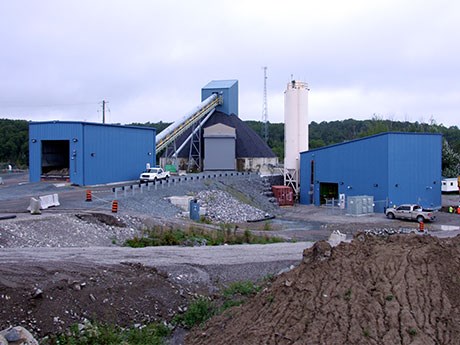Covered dome for sand allows for automation
The hydraulic backfill system at Totten Mine is state-of-the-art from the covered dome that stores up to 5,000 tonnes of sand to the remotely controlled underground diverter valves that dictate the final destination of the fill.
Golder Associates designed the plant and was accountable for building it, and Walden Electric supplied much of the labour.
Locally-sourced alluvial sand is trucked to Totten, dumped into a covered receiving dock, screened and conveyed to the top of the covered pile.
“At most other mines, the sand is stored in an open area,” said Bernie Parisé, operational readiness lead, “A covered sandpile allows for automation. At the same time, we eliminate any environmental impact from dust.
“Anytime we need to pour, we can start up the plant and begin pouring. We don’t have to call for an operator with a payloader to bring sand.”
The supplier, OCL Trucking and Custom Crushing, is automatically notified when the pile needs to be replenished. Over the course of a year, said Parisé, Totten will consume approximately 300,000 tonnes of sand.
Bulk, powdered cement supplied by Lafarge is stored in a tower and conveyed via a screw conveyor into a colloidal mixer with three fast-moving impellers that take water and cement and turn it into a slurry.
“It’s a way of ensuring a very consistent mix tied into our desire for good quality control underground,” said Parisé. “Once it’s produced at the proper ratio, it goes into a second tank, and from there it’s pumped into the main mix tank.”
Lafarge remotely tracks the volume of cement in the tower and dispatches tankers to top it up.
“Processed water comes from our polishing pond,” said Parisé. “It’s pumped up to our headframe and at that point a decision is made through our distributed control system as to whether the water is pumped to the backfill plant or if it’s used for process water in the mining activities underground.”
“The sand comes from the dome and is metered into the mixing tank. We have a density meter placed on the tank so we have a proper consistency, and from there it’s sent out and down through our underground distribution system to the voids to be filled.”
When there’s a stope to be filled, the plant runs 24/7 until it’s full because “the sooner we get it filled, the sooner we can continue with the mining process,” said Parisé.
The hydraulic fill is sent underground through two six-inch boreholes to the 1,250-level. Often, access to the boreholes is from inside the plant. At Totten, they’re outside, immediately adjacent to the plant, offering easier access if the line is plugged and a drill rig has to be brought in to clear the obstruction.
Otherwise, it would be necessary to take out the side of the building to accommodate the drill rig. The two holes ensure redundancy in the event that one gets plugged and is out of service for a period of time.
The preferred method of transport is through rock because rock wears predictably and lasts a long time, but water ingress problems over the first 500 feet of the boreholes forced Vale to use ceramic lined steel pipe to avoid dilution.
The backfill plant and the quality of the fill are critical. If it goes down, or if the quality of the fill isn’t right, the mining process grinds to a halt.
The backfill goes down to the 1250- level, across a 300-foot span and then descends again all the way to the 3625-level.
In other mines, directing backfill to the target stope is a high-risk manual process. At Totten, it’s all automated using diverter valves.
“So, now, all that work is done by pressing a button from the control room,” said Parisé. “We decide which stope to fill and send it down.”


